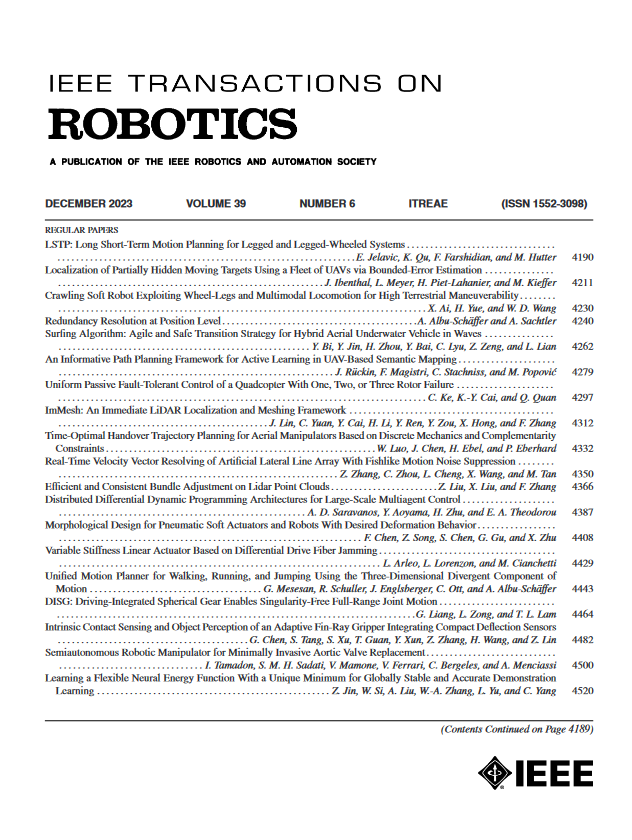论机器人学中矩阵加权状态估计问题的半无限放松
IF 9.4
1区 计算机科学
Q1 ROBOTICS
引用次数: 0
摘要
近年来,所谓的可认证感知方法的开发取得了显著进展,这些方法利用半有限凸松弛来寻找机器人感知问题的全局最优值。然而,这些松弛方法大多依赖于简化假设,例如各向同性的测量噪声分布,以方便问题的提出。在本文中,我们探讨了矩阵加权(各向异性)状态估计问题的半有限松弛的严密性,并揭示了其中潜藏的局限性:矩阵加权因素会导致凸松弛失去严密性。特别是,我们证明了有矩阵权重的本地化问题的半有限松弛只有在噪声水平较低时才可能是紧密的。为了更好地理解这个问题,我们引入了状态估计的后验不确定性与通过凸松弛得到的证书矩阵之间的理论联系。考虑到这一联系,我们从经验上探讨了导致这种严密性损失的因素,并证明可以利用冗余约束来重新获得严密性。本文的第二个技术贡献是,我们证明了当考虑矩阵权重时,标量加权同时定位和映射的最新松弛方法无法使用。我们提供了另一种表述方式,并证明除非使用特定的冗余约束,否则其半有限程序松弛并不紧密(即使是在噪声水平很低的情况下)。我们通过模拟数据和实际数据证明了我们的公式的严密性。本文章由计算机程序翻译,如有差异,请以英文原文为准。
On Semidefinite Relaxations for Matrix-Weighted State-Estimation Problems in Robotics
In recent years, there has been remarkable progress in the development of so-called
certifiable perception
methods, which leverage semidefinite, convex relaxations to find
global optima
of perception problems in robotics. However, many of these relaxations rely on simplifying assumptions that facilitate the problem formulation, such as an
isotropic
measurement noise distribution. In this article, we explore the tightness of the semidefinite relaxations of
matrix-weighted
(anisotropic) state-estimation problems and reveal the limitations lurking therein: matrix-weighted factors can cause convex relaxations to lose tightness. In particular, we show that the semidefinite relaxations of localization problems with matrix weights may be tight only for low noise levels. To better understand this issue, we introduce a theoretical connection between the posterior uncertainty of the state estimate and the certificate matrix obtained via convex relaxation. With this connection in mind, we empirically explore the factors that contribute to this loss of tightness and demonstrate that
redundant constraints
can be used to regain it. As a second technical contribution of this article, we show that the state-of-the-art relaxation of scalar-weighted simultaneous localization and mapping cannot be used when matrix weights are considered. We provide an alternate formulation and show that its semidefinite program relaxation is not tight (even for very low noise levels) unless specific
redundant constraints
are used. We demonstrate the tightness of our formulations on both simulated and real-world data.
求助全文
通过发布文献求助,成功后即可免费获取论文全文。
去求助
来源期刊

IEEE Transactions on Robotics
工程技术-机器人学
CiteScore
14.90
自引率
5.10%
发文量
259
审稿时长
6.0 months
期刊介绍:
The IEEE Transactions on Robotics (T-RO) is dedicated to publishing fundamental papers covering all facets of robotics, drawing on interdisciplinary approaches from computer science, control systems, electrical engineering, mathematics, mechanical engineering, and beyond. From industrial applications to service and personal assistants, surgical operations to space, underwater, and remote exploration, robots and intelligent machines play pivotal roles across various domains, including entertainment, safety, search and rescue, military applications, agriculture, and intelligent vehicles.
Special emphasis is placed on intelligent machines and systems designed for unstructured environments, where a significant portion of the environment remains unknown and beyond direct sensing or control.
 求助内容:
求助内容: 应助结果提醒方式:
应助结果提醒方式:


